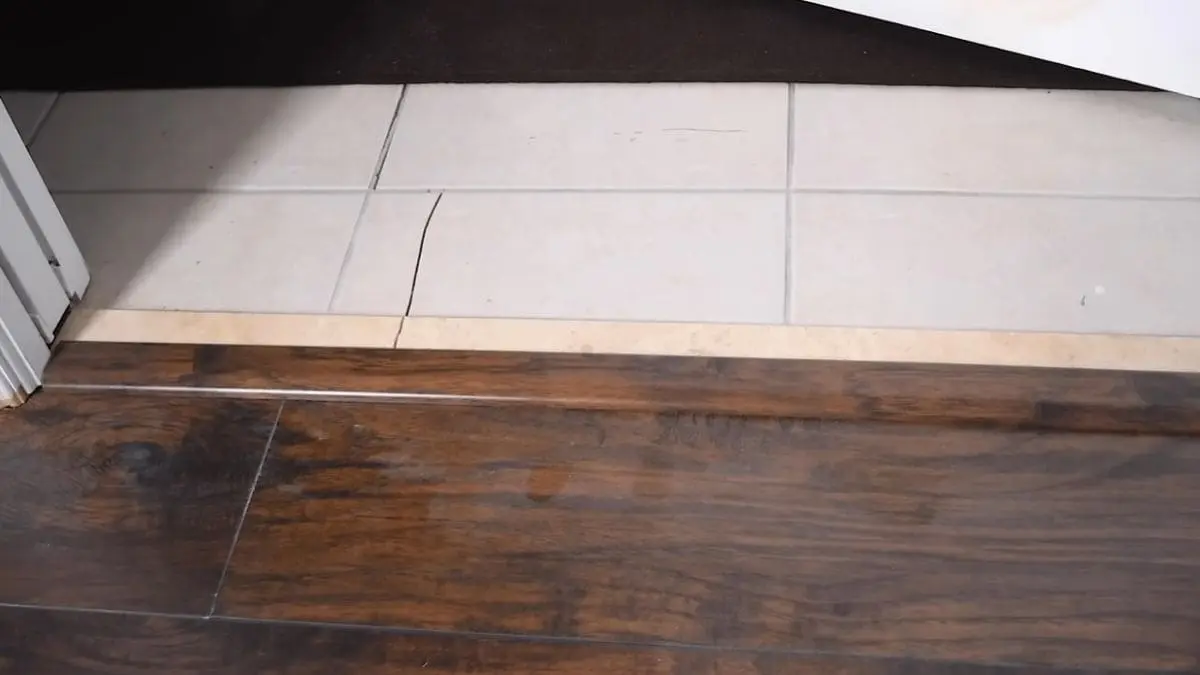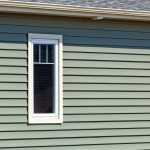When installing a floating floor, achieving a seamless transition where it meets an exterior door threshold is essential for both durability and appearance. A well-installed threshold transition prevents issues like moisture seepage, floor buckling, and temperature fluctuations that can damage the floor over time. Many homeowners and DIY enthusiasts face challenges with this junction due to the expansion and contraction properties of floating floors and the specific demands of exterior doors.
This guide provides a clear, step-by-step approach to help you handle this transition effectively. You’ll learn about key considerations, common challenges, and the right techniques to create a smooth, professional-looking finish that will stand up to heavy foot traffic and environmental factors.
Whether you’re using laminate, vinyl, or engineered wood, follow along to ensure your floating floor and door threshold meet seamlessly for lasting results.
What is a Floating Floor?
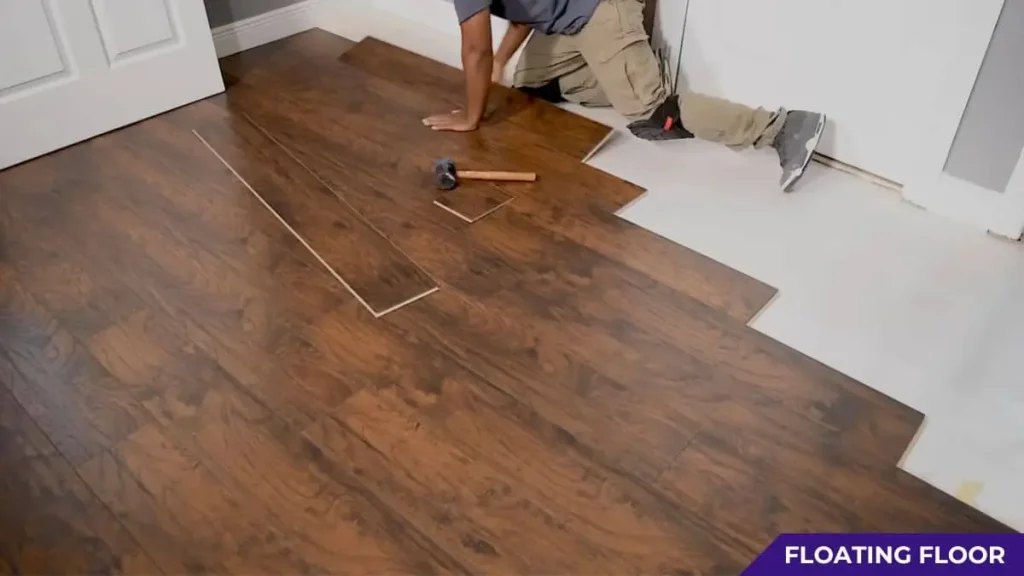
A floating floor refers to any flooring type that is not nailed, glued, or otherwise permanently fixed to the subfloor. Instead, it “floats” above the subfloor, held in place by a system of interlocking planks or tiles. Popular materials used for floating floors include laminate, vinyl, and engineered wood, which are chosen for their versatility and easy installation.
Floating floors are unique because they allow for natural expansion and contraction based on temperature and humidity, reducing the risk of warping or cracking. This feature, while beneficial for many spaces, poses a specific challenge when transitioning to fixed structures like exterior door thresholds.
Why Do Floating Floors Require Space for Expansion?
Floating floors respond to changes in temperature and humidity by expanding and contracting, a natural process essential to maintaining their structural integrity. To accommodate this movement, floating floors are installed with an expansion gap around the perimeter of the room, including around walls, cabinets, and other fixed points. This gap prevents the floor from buckling or lifting, especially in high-humidity conditions.
However, when it comes to connecting the floating floor to a threshold, this movement must still be respected, or the flooring could face issues such as edge wear, cracking, or moisture buildup over time.
What is an Exterior Door Threshold?
An exterior door threshold is the lower part of the door frame that acts as a transition point between the inside floor and the outdoors. Thresholds are typically built from durable materials like metal, wood, or composite to withstand foot traffic and exposure to weather.
They also serve a practical purpose of blocking drafts, moisture, and debris from entering the home. Properly sealing the threshold area is crucial, as it prevents water damage, pests, and thermal loss, all of which could harm flooring or increase energy costs.
Key Challenges of Floating Floors Meeting Exterior Door Thresholds
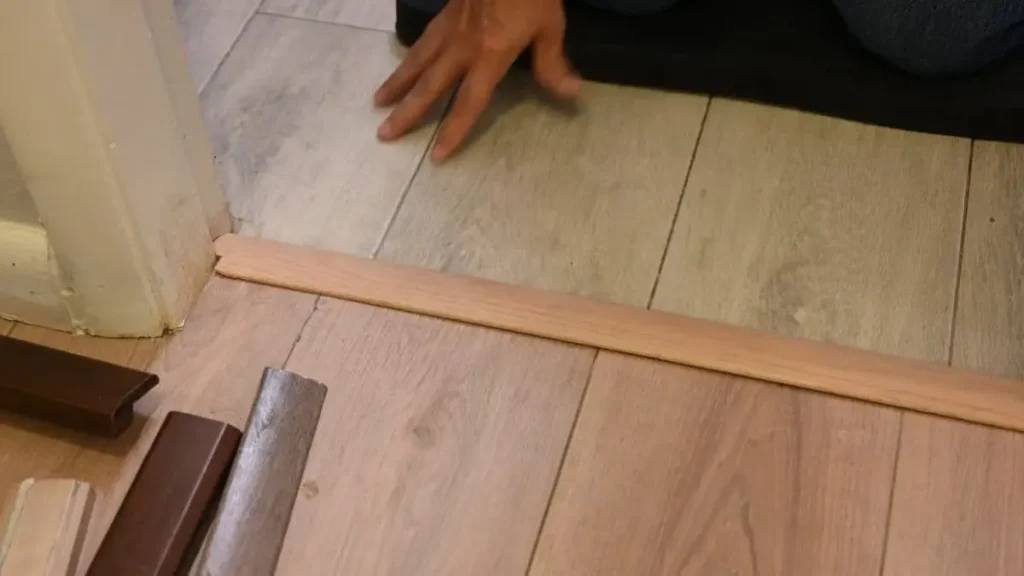
Managing Expansion and Contraction
Floating floors naturally expand and contract due to fluctuations in temperature and humidity. When meeting an exterior door threshold, this expansion movement needs to be carefully managed to avoid issues like buckling, lifting, or gaps. A critical challenge is maintaining an adequate expansion gap near the threshold to allow the floor to move freely without becoming restricted.
However, too large of a gap can lead to an unfinished look or leave the floor vulnerable to debris and moisture intrusion, which could damage the edges over time.
Addressing Moisture Concerns
Exterior door thresholds are exposed to outdoor elements, making moisture one of the most pressing concerns at this transition point. Without proper sealing, water can seep under the door and into the expansion gap, leading to swelling, warping, or mold growth in the floating floor material. Moisture barriers and threshold seals are essential for preventing this issue, but they must be compatible with the floating floor’s need for movement to prevent moisture from collecting around or beneath the threshold.
Creating a Smooth, Stable Transition
A smooth and stable transition between the floating floor and the door threshold is essential for both functionality and appearance. The transition must feel seamless underfoot and provide a consistent look between indoor and outdoor spaces. To achieve this, installers often use transition moldings, which bridge the gap between the floating floor and the threshold while maintaining the floor’s mobility.
However, not all types of molding are compatible with every floor material, and some may restrict expansion if improperly fitted, leading to a range of structural issues.
Selecting Appropriate Transition Moldings
Choosing the right transition molding is essential in creating a professional, durable finish where the floating floor meets the threshold. Molding options such as T-moldings, end caps, or reducer strips each serve a specific purpose and vary in terms of height, shape, and flexibility. Matching the molding to the floating floor’s thickness and material is important to ensure a tight fit that doesn’t restrict expansion or movement.
Additionally, moldings must be securely fixed to the subfloor or threshold, rather than the floating floor itself, to allow for the natural motion of the planks without causing damage or instability.
Dealing with Temperature Variability
Temperature changes affect floating floors and thresholds differently. While floating floors expand and contract in response to both temperature and humidity, threshold materials such as wood or metal respond differently to temperature alone. This discrepancy can create alignment issues at the transition point if not properly accounted for during installation. Temperature variability also affects adhesive durability and the integrity of expansion gaps, making it essential to select materials and installation techniques suited to the climate in which the floor is installed.
Step-by-Step Guide to Handling Floating Floor and Door Threshold Transitions

Step-1: Gather Necessary Tools and Materials
Before starting, gather all tools and materials needed for a successful transition. Common items include a tape measure, level, saw, transition molding, adhesive, and moisture-resistant sealant. Additionally, ensure you have the appropriate type of transition molding for the floating floor material, such as T-molding or end caps. By preparing these items ahead of time, you can minimize interruptions and ensure a smooth, efficient installation.
Step-2: Measure and Mark the Expansion Gap
Measuring and marking the expansion gap is crucial to maintaining the floating floor’s flexibility at the threshold. Start by determining the recommended gap size for your floor type—this is typically between 1/4 inch and 1/2 inch, though it may vary based on manufacturer guidelines. Use a tape measure to mark the gap along the threshold, ensuring a consistent width to prevent issues with movement. The transition molding will later cover this gap, ensuring both functionality and aesthetics.
Step-3: Install a Moisture Barrier (If Necessary)
For areas where moisture is a concern, particularly at exterior door thresholds, install a moisture barrier to protect the floating floor. Cut the barrier to size and fit it along the floor near the threshold, ensuring it covers the expansion gap but does not restrict floor movement. Proper moisture protection is essential to prevent water from seeping into the floor planks, especially in high-humidity or rainy climates. If your flooring includes an underlayment with moisture protection, ensure it overlaps slightly with the barrier near the threshold for complete coverage.
Step-4: Fit and Cut the Transition Molding
Position the transition molding over the expansion gap to measure and mark the length needed. Use a saw to carefully cut the molding to fit snugly across the threshold. Many moldings come in different profiles and materials, so be sure to match the molding to the flooring’s thickness and type. Once cut, test fit the molding to confirm it covers the gap without restricting movement. Ensure the molding aligns smoothly with the threshold and the adjacent flooring to avoid uneven surfaces.
Step-5: Secure the Transition Molding in Place
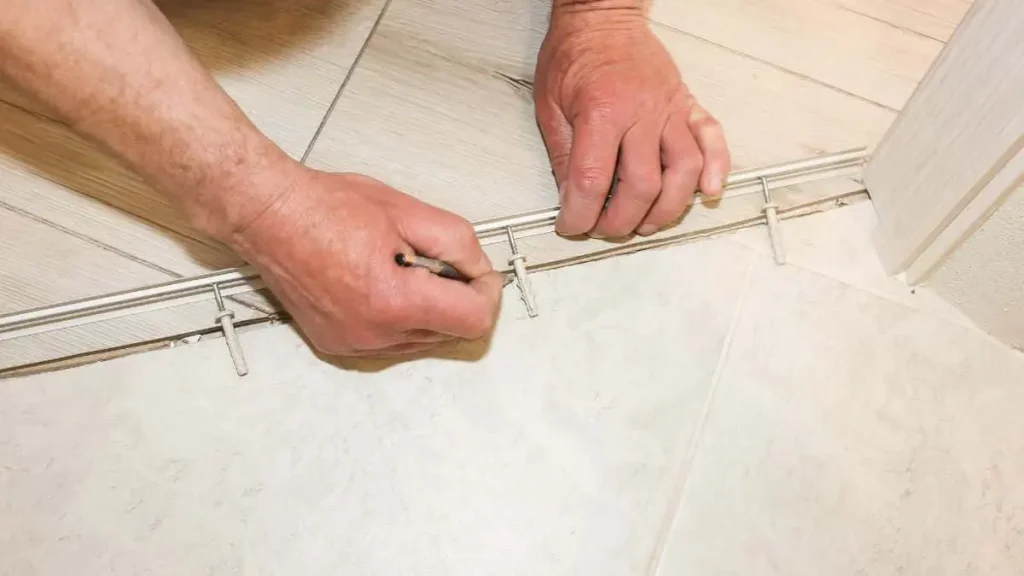
With the molding cut and test-fitted, proceed to secure it in place. Apply adhesive or screws to fix the molding, following manufacturer recommendations. Do not attach the molding directly to the floating floor, as this could prevent expansion and lead to buckling over time. Instead, secure the molding to the threshold or subfloor, allowing the floating floor to expand and contract freely beneath it. Use a level to confirm the molding sits evenly and avoid any sharp edges or protrusions that could cause tripping.
Step-6: Apply Sealant to Ensure a Moisture-Resistant Finish
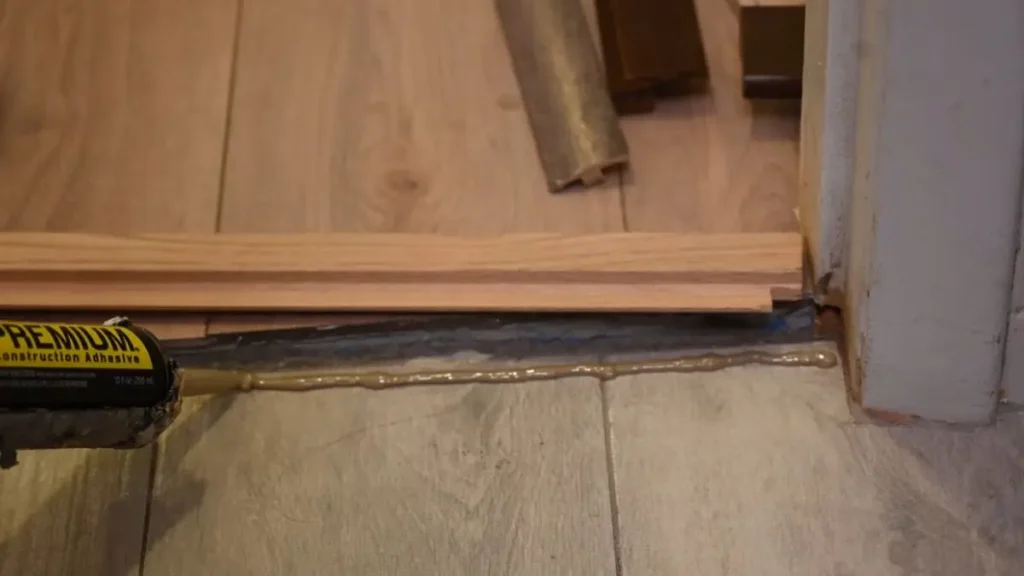
To complete the installation, apply a moisture-resistant sealant along the edge of the molding where it meets the threshold. This step helps to seal the transition point against water, dirt, and debris, especially in exterior areas where exposure to elements is a concern. Be careful not to seal the expansion gap entirely, as the floating floor still needs room to move. Allow the sealant to dry according to the manufacturer’s instructions before walking on or cleaning the area.
Recommended Post: Baseboard Transitions for Different Floor Heights
Best Practices for Floating Floor Transitions at Exterior Doors
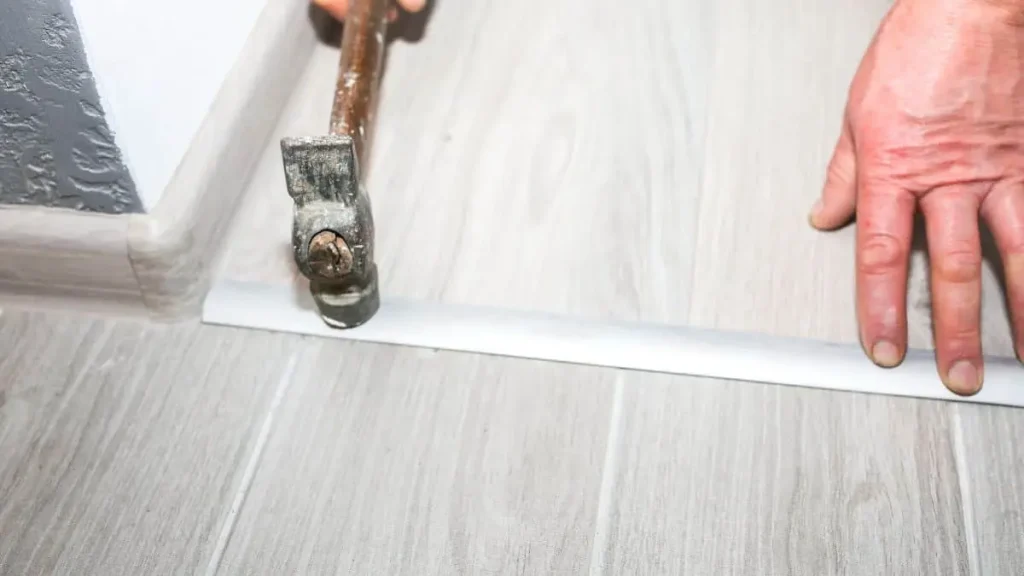
Choose the Right Transition Molding
Selecting the appropriate transition molding is crucial for a successful floating floor installation at exterior doors. Consider the flooring type, thickness, and color when choosing the molding. For instance, T-molding is ideal for connecting two floors of equal height, while reducer molding works best when transitioning from a higher floor to a lower one. Ensure the molding is durable and moisture-resistant, as it will be exposed to varying environmental conditions.
Maintain Proper Expansion Gaps
Properly maintaining expansion gaps is essential for the longevity of your floating floor. Always follow manufacturer guidelines regarding the recommended gap size, which typically ranges from 1/4 inch to 1/2 inch. These gaps allow the flooring to expand and contract with temperature and humidity changes. Avoid filling the gap with rigid materials or adhesives, as this could lead to buckling and warping over time. Regularly check the expansion gaps to ensure they remain clear and unobstructed.
Regularly Inspect and Maintain Transitions
Periodic inspection and maintenance of the transition areas will prolong the life of both the flooring and the threshold. Look for signs of wear or damage, such as gaps forming, moldings becoming loose, or signs of moisture intrusion. Address any issues promptly to prevent further damage. Cleaning the transition area regularly will also help maintain its appearance and functionality, removing dirt and debris that can accumulate over time.
Ensure Adequate Drainage and Weatherproofing
When installing floating floors near exterior doors, it is vital to ensure adequate drainage and weatherproofing. Check that door thresholds are positioned to direct water away from the entryway and flooring. Consider installing a door sweep or weather stripping to prevent water from entering the home. If necessary, apply a water-resistant sealant along the transition edges to provide an extra layer of protection against moisture intrusion.
Consult Professionals When Necessary
If you encounter challenges during the installation process or are unsure about specific steps, do not hesitate to consult professionals. Experienced contractors can provide valuable insights and assistance, ensuring a proper and lasting transition. Professional help can be particularly beneficial for complex installations or when working with specialized materials, providing peace of mind and ensuring adherence to best practices in the industry.
Solutions to Common Issues with Floating Floor and Threshold Transitions
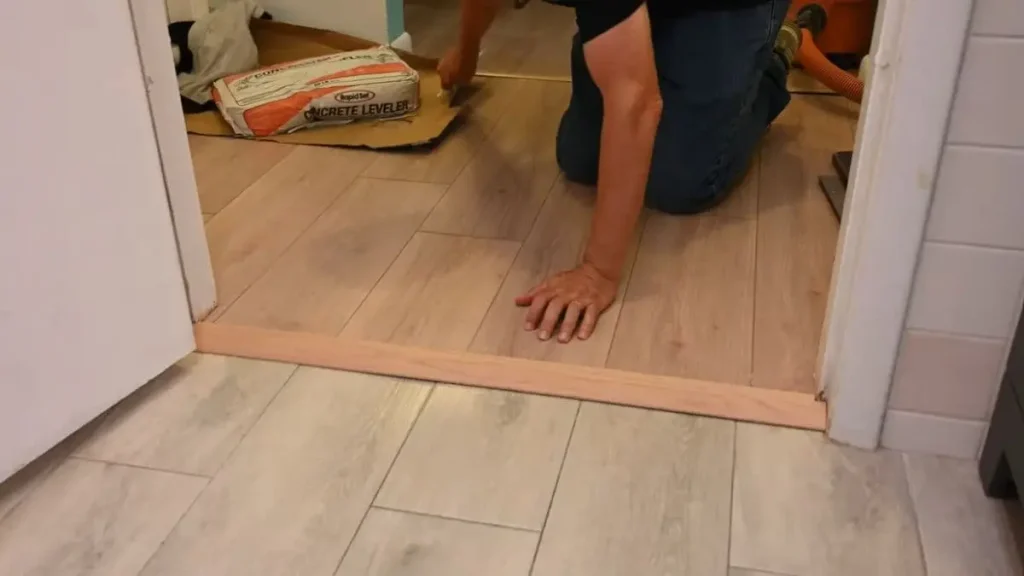
Gaps Between the Floor and Threshold
Gaps between the floating floor and the door threshold can occur due to improper installation or settling over time. To address this issue, first assess the gap’s size. If it is minor, you can fill it with a flexible caulk or foam sealant to prevent dirt and moisture from entering. For larger gaps, consider adjusting the threshold height or using additional transition molding to create a seamless appearance. Ensure that any adjustments maintain the required expansion gap for the flooring.
Buckling or Warping of the Floating Floor
Buckling or warping of the floating floor often results from moisture exposure or inadequate expansion gaps. To resolve this issue, first identify the source of moisture and eliminate it. This could involve improving drainage around the exterior door or using dehumidifiers in the area. If the flooring has already warped, you may need to remove and reinstall the affected planks, ensuring that proper expansion gaps are maintained during the installation process.
Improperly Aligned Transitions
Misalignment of transition moldings can detract from the overall appearance and function of the flooring. If you notice that the moldings are not properly aligned, carefully remove them and reposition them according to the flooring layout. Ensure that the edges of the molding align seamlessly with both the floating floor and the threshold. If necessary, use spacers to maintain consistent gaps while reinstalling the transition moldings.
Moisture Intrusion at Thresholds
Moisture intrusion at the threshold can lead to significant damage to both the flooring and the door structure. To prevent this issue, regularly inspect the exterior door area for signs of water accumulation. Ensure that the door threshold is properly sealed and that there are no cracks or gaps where water can penetrate. Applying a weather-resistant sealant around the threshold can provide an additional barrier against moisture. If water damage has occurred, it may be necessary to replace affected flooring sections and repair any structural damage to the threshold.
Damage to Transition Moldings
Transition moldings can sustain damage from foot traffic, furniture movement, or moisture exposure. To repair damaged moldings, assess whether the damage is superficial or requires complete replacement. If the damage is minor, sanding and repainting or refinishing the molding may suffice. For significant damage, such as cracking or splitting, removing the damaged molding and replacing it with new, properly sized-molding is recommended. Ensure that the new molding is compatible with both the floating floor and the threshold to maintain a cohesive look.
Read Also: Garage Door Concrete Threshold Repair
Frequently Asked Questions (FAQs)
1. How do I choose the right transition molding?
Choosing the right transition molding involves considering the flooring type, thickness, and color. T-molding works for equal-height floors, while reducer molding suits transitions from higher to lower floors. Ensure the selected molding is durable and moisture-resistant, especially for areas exposed to the elements, to maintain functionality and aesthetics.
2. Why are expansion gaps important for floating floors?
Expansion gaps are crucial for floating floors as they allow the flooring to expand and contract without buckling or warping. These gaps accommodate temperature and humidity fluctuations, ensuring the longevity of the flooring. Typically, a gap of 1/4 inch to 1/2 inch is recommended around the perimeter and any fixed objects.
3. How can I prevent moisture issues at exterior door thresholds?
To prevent moisture issues at exterior door thresholds, ensure proper drainage around the entryway. Use weather stripping or door sweeps to block water from entering. Regularly inspect and seal any gaps with a water-resistant sealant to protect both the threshold and the adjacent floating floor from moisture damage.
4. What should I do if my floating floor is buckling?
If your floating floor is buckling, first identify and eliminate the source of moisture, as it can cause this issue. Next, check if the expansion gaps are adequate. If buckling persists, you may need to remove and reinstall the affected planks, ensuring proper gaps are maintained during the process.
Conclusion
Handling the transition between floating floors and exterior door thresholds requires careful consideration and execution to ensure both functionality and aesthetics. By understanding the unique challenges posed by these areas, following a step-by-step guide, and adhering to best practices, homeowners can achieve seamless transitions that enhance their living spaces.
Addressing common issues promptly and effectively will prolong the life of your flooring and maintain a polished appearance. Whether you are a DIY enthusiast or hiring a professional, these insights will empower you to make informed decisions, ultimately leading to a successful home remodeling project.

